|
Bahamas
- August 2005

|
This
was the dream, clear skies and nothing but deep blue water as I prepared
for another dive. All I had to do was stand; another world was a mere
stride away. Was this only a dream induced by Dramamine? Or could it be
reality, diving and living aboard the extremely stable platform of the
Nekton Pilot?
We
had talked about the ease and adventure of spending a week at sea diving
the little visited spots and enjoying the company of fellow divers. The
few times we had tried to arrange such a trip it always seemed to hit a
snag and we ended up at land based resorts. But this time we were wheels
up and headed for a rendezvous with Nekton Diving Cruise’s original
ship, the Nekton Pilot and a week of diving their Northwestern Bahamas
itinerary.
We
flew down to Miami to meet up with my brother Mike, and his wife Maria on
a Friday night. The four of us would meet the rest of our group from the
dive shop on Saturday to begin our voyage.
The plan was to contact Nekton’s representative at Fort
Lauderdale’s airport, where they pick up passengers as flights arrive.
Everyone is dropped off at Las Olas Riverfront for a little sightseeing
and dinner while they stow your luggage on board. Once the week’s guests
have assembled, Nekton’s buses transport the entire group to the ship at
Port Everglades with a convenient stop for last minute supplies at a local
supermarket, pharmacy and package store.
|
|
Both
of Nekton’s boats are nearly identical. When the Pilot was delivered in
1994, it was the first SWATH vessel built specifically for diving.
Measuring approximately 80 feet by 40 feet, it doesn’t appear to be your
typical boat. In fact, at first glance it reminds one more of an offshore
oil platform than a liveaboard. But the secret of its stability lies in
its unorthodox appearance. The SWATH (Small Waterplane Area Twin Hull)
technology allows the Pilot to ride on its twin-submerged hulls below the
choppy water thus minimizing the effects transferred to the boat. Kelli,
who is sometimes affected with motion sickness, was concerned about
spending a week on a boat. However she reports that she never even felt
queasy during our time at sea.
The
Pilot has three decks. The Mola Mola Deck is the upper sundeck complete
with a hot tub and covered area. The pilothouse is also located here. All
of the pre-dive briefings are given under the awning. The middle deck is
known as the Grouper Deck. The main Salon, dining area and galley are here
along with seven guest cabins. The Coral Deck is home to the rest of the
guest cabins (9) as well as the crew’s quarters. All of the guest cabins
have large picture windows (no stupid little portholes here!) as well as
individual AC controls and private heads. They were either setup with two
twin beds or a single queen. Given the choice, the cabins on the Grouper
Deck are definitely the way to go.
|
|
|
|
Just
aft of the dining area on the Grouper Deck is the open-air camera area.
There are two large cameras only tables as well as a large ice cooler for
everyone’s use. The stairs here lead down to the elevating dive
platform. Once you set your gear up at the start of the week it remained
here until you finished diving. Whips from the compressor allowed the
tanks to be refilled in place. After your dive you simply removed your
first stage to alert the crew that the tank had been used. They would
quickly refill the cylinder; replace the first stage and you were ready to
go. They use steel 100cu ft tanks for the most part on the Pilot, some
people like them for their buoyancy characteristics and some (like us)
don’t. They do have some Al 80’s, which we opted for.
Bins were located beneath your station for storage of fins, masks,
weight belts and any other incidentals. It was all fairly effortless!
But
I’m getting somewhat ahead of myself. The buses dropped us off at
Nekton’s pier and we boarded the boat to find our luggage already stowed
in our cabin. We had a bit of customs paper work to complete for our entry
into the Bahamas the next morning. Then came the safety briefing and a
general orientation before our final task, the required life vest drill.
After that we settled in to assemble cameras and get to know the other
passengers. Travel has a way of wearing you out. Combining that with the
gentle swaying of the boat as we headed out over the Gulf Stream and sleep
came easily.
We
awoke the next morning to brilliant blue skies and gleaming water.
Breakfast was served as we waited for our Purser Jeff to clear us through
customs at Grand Bahama Island and on to our first dive site at Indian
Caye.
|
|
|
|
We
began the typical dive schedule for the week. Just after breakfast, dive
briefings were held under the awning where one of the divemasters would
draw an elaborate sketch of the site and point out the locations of some
of the more noteworthy attractions. Afterwards the dive deck would be
opened for business. The boat would usually stay moored at the same site
throughout the morning allowing plenty of time for two dives with a break
in between for fresh cookies! This plan allowed everyone to go at their
own pace and alleviated the need for a mad rush to get to the dive
platform. Then as lunch was served the boat would be repositioned for the
afternoon dives. Time was scheduled for two dives before a break for
dinner. After the evening
feast, one of the crew would then put on a presentation concerning the
local reef inhabitants. One night we learned of the secret life of turtles
and another was about tunicates. You might think that tunicates wouldn’t
hold the average persons interest for very long, but I was surprised at
what I Iearned. Before this I had never paid much attention to these
innocuous creatures, but after learning of them we delighted in finding
their intricate colonies.
At
the end of the presentation the dive deck was once again open for a night
dive. After spending the afternoon on the same reef it was easy to find
your way around and see the change in the inhabitants. This is not to say
that no navigation skills were needed. On several occasions the boat would
swing around on it’s mooring with the tide and a minute to re-orient
yourself was needed. A hot shower and a warm towel were always waiting for
you upon surfacing along with the evening’s snack. We tended to gather
on the sun (moon?) deck after the last dive to compare notes from the
day’s activities and enjoy the star filled sky. There’s just something
about being out on the open ocean with no city lights to spoil the view of
the stars. I don’t know how many shooting stars we counted during the
week.
The
crew was always available for a guided dive, but our group was comprised
of the more adventurous (and experienced) divers and never took them up on
it (though we did see them in the water with others). Mostly they were
always there on the dive platform to lend a helping hand, share a joke, or
pass you your camera.
We
did divert from the “normal” schedule on a couple of occasions, the
best being the search for wild dolphins on White Sand Ridge. After moving
overnight from our dives at Scoto’s Reef we awoke to find dolphins
playing in our bow wake. Everyone
excitedly finished breakfast and met on the dive deck. The crew has found
that if they cruise around in circles the dolphins will become curious and
come to investigate. It seems they can’t resist the opportunity to play
in the bow wake. Once they have the dolphins’ attention, the crew stops
the boat and it’s time to hit the water!
|
|
We
tried to slip into the water as the dolphins returned to their hunting
routine. Several female dolphins were in the process of teaching their
calves to locate and catch fish buried in the sand. Even at the slow pace
we had a hard time keeping up. You had to constantly kick just to stay
abreast. Once you caught up, diving down to get a closer look and maybe
snap a picture or two was about all I could manage! Surfacing sputtering
and out of breath it was time to start the chase again. We were told
during the briefing the dolphins would quickly become bored unless we were
diving down and generally acting crazy to keep their attention. So there
was no time to stop and catch your breath as long as there were dolphins
around! We kept up as long as we could, until they finally decided it was
time to re-board. It was probably just in the nick of time before I slowly
sank down to the bottom.
We
all climbed back onto the dive platform exhausted but with smiles pasted
from ear to ear. We had done a dolphin dive while on Roatan and had seen
wild dolphins pass by while diving in Belize, but this was the first time
we had been afforded the opportunity to actually interact with wild
dolphins and it was thrilling!
Most
of the diving on the Northwest Bahamas itinerary was fairly shallow (there
were some exceptions like Theo’s wreck, and the Thumbnail) and loaded
with fish. Some of the wreck dives were the most crowded with our finned
friends. You could hardly see the Sugar Wreck because of all the fish.
Grunts were packed into every crack and crevice, barracuda patrolled in
squadrons, and an octopus prowled around through the debris. The lack of
depth at this dive site allowed the sun to play off the pillar coral and
made for great photo opportunities. At times the clouds of fish were so
thick you could barely see. At one point they completely masked one of the
largest pieces of pillar coral we have ever encountered.
|
|
|
|
We
were on site to do this dive three times – twice in the afternoon and
one night dive. The local residents make a noticeable change with the
setting sun. Turtles, stingrays and porcupine fish now dominated the
wreck. This is definitely a “can’t miss” dive.
Here
are a few of our other favorites. The
Wreck of the Hesperus was teeming with fish by day and home to enormous
Loggerhead turtles at night. One
of them was so large and bold it literally ran right into our friend Cathy
as she shot video. Each
turtle seemed to have at least one and sometimes two or more remora
attached to its shell. But we
did find one lonely remora just sitting in the sand waiting to hitch a
ride. The Thumbnail was a
fairly deep dive and held many treasures.
An octopus named “Herbie” had a lair just off the descent line
with the shells of his dinner lining his front porch. He was obviously
well fed because he looked like a 20-pound cephalopod in a 10-pound hole.
We spotted several brilliant colored angels as well.
I even spotted a Blue Angelfish along the miniwall that dropped off
the formation (which really did take the shape of the thumbnail). Later in the week, we discovered Rocky Mountain High and
thoroughly enjoyed all the marine life.
The visibility was not very good that morning and it forced us to
look more closely at things in short range.
We found several varieties of tunicates and wondered how many of
those we’d missed before learning so much during the presentation on
board. At the end of the week
we explored Tuna Alley. We only did this dive once, but we saw several
small schools of graceful Atlantic Spadefish, a few Sargassum Triggers,
and a tuna. But the highlight
of Tuna Alley was a fantastic swim through. It was adorned with
multi-colored sponges that were illuminated by overhead “skylights.”
It was worth several passes through it to take it all in.
|
|
|
|
If
you’re wondering about the food on a boat a fraction of the size of a
cruise liner, here’s a brief rundown.
Each morning, breakfast had one major entrée like bacon and eggs,
pancakes, sausage gravy and biscuits, or some other very filling main
course. For those who wanted a little less, there was always lots of
fresh fruit, bagels, or cereal, too.
Did we mention the cookies? I
think so, but it’s worth repeating you don’t want to miss the warm
cookies, fresh from the oven, served every day between the two morning
dives. And leftover cookies
were held over for midday dessert.
Lunch ranged from pasta salad, tacos, hamburgers and hotdogs, BLTs,
to homemade lasagna. Arminda
was a very good cook!! Each
afternoon, she put out appetizers about 4pm as people started to come in
from diving. They were
always hot and fresh, too. We
were usually still to full from lunch to partake, but Cuban meat pastries,
nachos, and small spring rolls were a few I remember seeing.
Prime rib with potatoes, fresh tilapia with rice and veggies, a
full turkey dinner, pork roast with veggies, shrimp with pasta, and BBQ
ribs rounded out our dinner menus. Each evening dinner came with salad and
homemade dessert as well. If
you go hungry on the trip, you apparently slept through mealtime.
Two
shore excursions were offered on our weeklong itinerary, one in Freeport
and another in Bimini. We
skipped Port Lucaya (Freeport), but not for any particular reason other
than we didn’t want to miss the opportunity to see sharks at Shark
Junction. This spot is adjacent to UNEXSO’s shark feeding site, and
while they don’t do a shark-feeding dive on the Nekton, we understood
that sharks might linger in the area looking for a hand out.
We
took a bearing to the feeding spot and jumped in. Right away a reef shark
cruised by and our hopes were running high to get some good pictures. The
site is a maze of narrow channels winding through the coral up to a large
sand patch. This is where they do the actual feeding. We worked our way up
to the sand and looked all around before deciding to head back to the
coral where the visibility was better.
We encountered three more sharks briefly during the dive, but none
ever close enough for a shot. This sort of set the tone for the week’s
shark sightings – a couple here and there, but not the bonanza people
claimed in the scuba magazines. Oh well, there was still plenty to see.
|
|
We
did decide to go ashore at Bimini. We
passed several other live-aboards anchored near us on the short ride into
Alicetown. We walked down the
main street and toured the little market area looking for trinkets and
such. We stopped in one of the small stores for sodas and took some
pictures of the islands’ architecture.
It would have been easy to hang around at one of the intriguing
little bars here and drink tropical concoctions, but with two dives left,
we opted to just head on back when the next group was brought in from the
Pilot.
|
|
The
dive site we were tied up at looked intriguing too. It was a place they
called The Strip for a good reason, the coral ran in a long strip parallel
to the shore. We donned our gear and went exploring. The small wall of
coral was covered in grunts, with several schools of goatfish congregated
together. I found three scorpionfish on the first pass! I always thought
that for every one I found that there were probably two others that I
missed. We also saw a variety of eels – green moray, white spotted,
goldentail and a mystery eel living in a hole with another.
We had such a good dive that we did it again a little later and it
also made an excellent night dive. On
that outing, we discovered all manner of crustacean.
The channel clinging crabs were having a convention.
The lobsters and eels were out in force as well.
We even saw the same two enormous rainbow parrotfish from the
afternoon dive literally tucked up into holes so tight they looked wedged
inside. This was also the
site we spotted the two largest banded
coral shrimp we’ve ever seen. The
were each about two to three inches in length and they were at the exact
same spot all three times we passed.
This relatively small patch of coral proved to be excellent for
creature hunts over and over.
|
|
That
night (Thursday) we had the weekly photo contest.
With a boat full of avid diving photographers, this proved to be
quite entertaining. First all the entries are shown on the flat screen TV.
After everyone had a quick look, the voting begins with the boisterous
crowd calling out to discard this image or that. Finally when the crowd
has whittled the number down to the final four, the winner was judged on
applause. Unfortunately, Nekton has discontinued their onboard E6 film
processing so entries were limited to digital images – which further
whetted our interest in upgrading our primary camera. To our delight, a
contestant from our group took top prize!
Way to go Andy!
On
our last evening, we watched the video put together by Nekton’s staff.
It included scenes from both above and underwater ranging from
snorkeling with dolphins, to the crew’s ongoing antics. Since the crew
is included in the video, it makes a nice souvenir of the weeks dive sites
and the personalities on board. Later
we sat up on the deck and enjoyed the last of the shooting stars and
relived the week’s highlights. As
the captain pulled up anchor and fired up the engines for our final
crossing, we took advantage of our last opportunities to gaze out over the
water and experience the gentle swaying as we traveled back toward Fort
Lauderdale.
Saturday
morning came very early and the realization that cruise ship passengers
from the massive ship beside us could see directly into our cabin hurried
us along as we dressed and packed the last of our belongings. We ate our breakfast and awaited the arrival of a customs
officer who cleared us through immigration.
As it seems to be a pattern with our trips lately, everyone else
had plans to head home immediately after our cruise, but we decided to
stay and play for a little while longer. We said goodbye to the staff and
the rest of our group and we were on our way back to Mike’s in Miami by
10:00am. Our first trip on a live aboard had been a great experience.
Now we were really looking forward to our stay aboard the Big Blue
Explorer in February 2006.
After
taking a day off to dry out we had made plans to meet our friends Mickey
and Cathy for a chance to dive the wreck of the Spiegel Grove. This was a
particularly intriguing opportunity since hurricane Dennis had completed
the original sinking plan. Since 2002 when the Grove was sent on it’s
final mission as an artificial reef, she had sat on her starboard side.
When hurricane Dennis raked the Keys in July 2005 everyone was surprised
when they found the ship sitting upright.
The
six of us met at the dock in Key Largo at 8:30 to head out with Blue Water
Divers for a two tank trip to the newly righted Grove. They are one of the
smaller operations in Largo, but they aren’t short on diving freedom.
Their 30’ boat, Blue Water Diver was well equipped with radio,
oxygen and first aid kit. They also required at least an Advanced Open
Water certification to do these dives.
We
embarked with a full compliment of divers (8) for the short ride to the
site. The Spiegel Grove is a large wreck, which affords multiple mooring
points that are first come first served. One of the stern markers was free
so we would start our exploration from there. After a quick check of the
current we hit the water and started down the mooring line. The outline of
the ship came into view almost immediately. It was so large that it was
impossible to see the whole thing, let alone see it all in one dive.
|
|
A
large landing craft repair bay partially covered by a helicopter landing
pad dominates the stern of the ship. Small cranes stand at the ready along
both sides offering lots of nooks and crannies for marine life to take
hold. I was surprised to see the amount of life still attached to the ship
after it’s dramatic flip. We worked our way forward amid schools of
swirling silversides until we reached the antiaircraft battery.
Unfortunately, the depth of the wreck (134’ to the bottom and 65’ to
her highest point) forced us to turn around and work our way back to the
mooring line at this point. The immensity of this ship really struck me
waiting on the line during the safety stop.
|
|
Unlike
the other charters who retreated to the shallower sites for the second
dive, we simply moved around to another vacate mooring ball and waited
through our safety stop for another crack at the Grove.
This time we were tied up to the bow. We dropped over the side and
pulled ourselves along the granny line against the surface current to the
down line. The eerie shape of the bow materialized as we descended. The
deck of the ship is literally covered with clamshells! This seemed fairly
strange, but they were everywhere. You had to wonder how they stayed on
while the ship was rolling over. Once again I was struck by the amount of
sponge growth that has already taken hold (and obviously held on tight!)
to the hull of a ship that has only been down three years.
We
swam back and forth through several of the large openings playing follow
the leader with a couple parrotfish. And then, all too quickly, our no
decompression time slipped away and we were forced to start our ascent. As
I turned to head up the ascent line everyone was already perched there
waiting out their safety stops. Mike, Maria, Mickey, Cathy, and Kelli
looked like birds on a wire. They
must have been far more anxious to rinse their own gear than I was.
I miss the Nekton already!!
|
|
It
had been a great week (plus a couple extra bonus days tacked onto the
end). Our first liveaboard had been a fantastic experience! The pure ease of diving and the beauty of staying on the
water for a week will weigh heavily in our plans for future trips. From
now on any destination that is home to a dive vessel will definitely get a
lot of consideration in our decision.
|
|
Our Crew
|
|
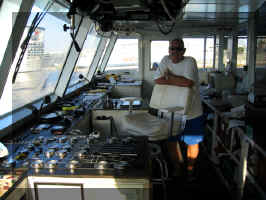
|
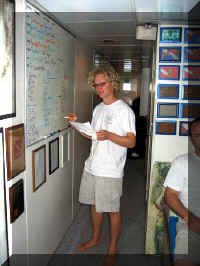
|
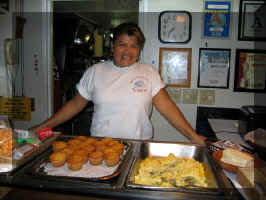
|
| Captain
Ephey |
Jeff |
Arminda |
|
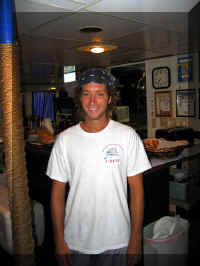
|
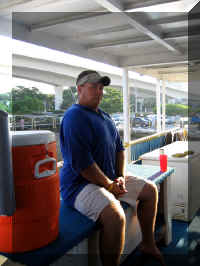
|
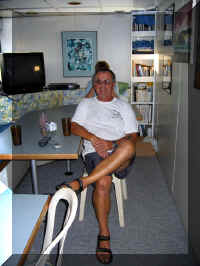
|
| Geoff |
"Big
Daddy" |
John |
|
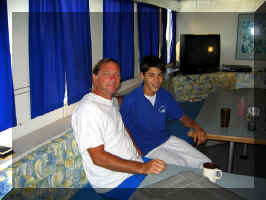
|
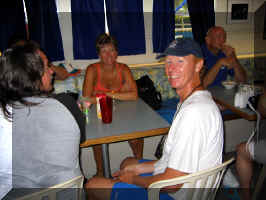
|
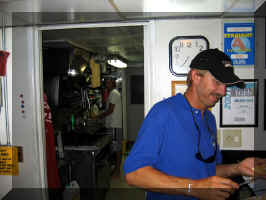
|
| Jon
& Nik |
Troy |
Mike |
|
|
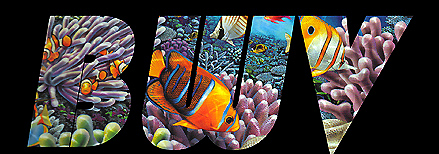 Blue
Water Visions
Blue
Water Visions